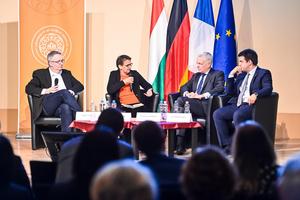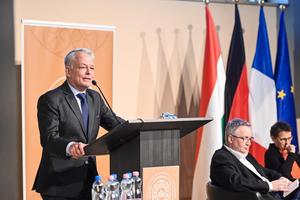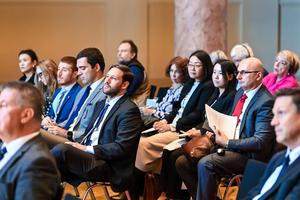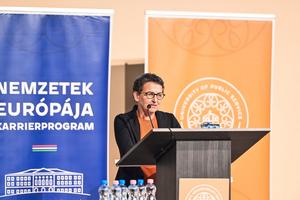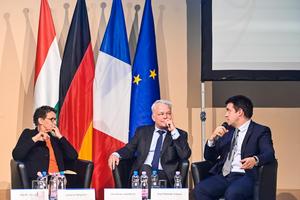The China policies of Germany and France, as well as their comparison with Hungary's practices, were the focus of the latest event in the Ludovika University of Public Service (LUPS) Eötvös József Research Center (EJRC) John Lukacs Institute and the Habsburg Ottó Foundation’s Europe Club series, held at LUPS on October 18.
At the end of 2020, as the EU Council’s rotating presidency, Germany finalized the EU-China investment agreement. Since then, the relationship between the Asian country and the continent has undergone numerous changes, and China's position seems to be strengthening globally. Various EU member states are building their relations with China based on different strategies, while reports on the benefits and risks of these relations continue to emerge.
In his welcome address, Gergely Prőhle, Program Director of the John Lukacs Institute at the Eötvös József Research Center, said that Christian Geinitz's book on China, published by Frankfurter Allgemeine Zeitung, inspired him to hold a conference to discuss China’s influence in Europe with experts. He added that the relationship between Hungary and China plays a significant role in the country’s foreign relations and in how European institutions and other European countries view Hungary’s external ties. Therefore, comparing the relationships between China and Germany, China and France, as well as China and Hungary, could be of interest.
In his presentation, Christian Geinitz, a journalist for Frankfurter Allgemeine Zeitung, discussed how Chinese investors are purchasing European companies with billions of euros, especially targeting German brands such as Daimler, Steigenberger, and BioNTech. The goal of this expansion is clear: by 2049, China aims to surpass industrialized nations and achieve global market leadership in every forward-looking sector, as part of the “Chinese dream” and the nation’s great rejuvenation. According to Geinitz, this poses a threat to Germany and Europe, and the continent must respond in a coordinated manner.
Geinitz pointed out that, in theory, it should be welcomed that Asians are investing in infrastructure and companies. However, skepticism and resistance are growing, as Beijing pursues political goals and refuses to fully open its own markets. Although the COVID-19 pandemic slowed the expansion, it did not change China's long-term objectives. Geinitz also highlighted that concepts such as socialist strength, modernity, and prosperity are not mutually exclusive. The Chinese model has shown that a non-democratic one-party system can still guarantee stability and foster national loyalty. Nevertheless, China’s growth and influence present both significant economic opportunities and major challenges for industries worldwide. Europe, Geinitz argued, must neither close itself off nor adopt China’s business practices, but if the EU presents a united front and recognizes that Beijing depends on it more than ever, Europe can help shape the terms and grow alongside China.
Valérie Niquet, Senior Research Fellow at the Foundation for Strategic Research, noted that Europe has a desire to "decouple or at least reduce Chinese risk," but this is not a realistic option. Rather, the goal should be to moderate dependence on China. Although China is a competitor, its market and investments are vital for many companies. "Europe continues to want to do business with China, but we are much more cautious than before," she said. According to Niquet, China’s economic growth is slowing compared to earlier years, but its social needs demand continuous financial input. For this reason, China seeks access to key European, American, and other Asian markets, as African, Central Asian, and Russian markets are insufficient to sustain its growth.
Niquet also observed that France is often accused of having a US-averse, China-friendly policy. However, China’s presence offers developmental opportunities, and the EU remains very interested in maintaining a stable relationship with China. Europe is less divided on how to interact with China and more unified in recognizing what China is willing to do for the stability of its own region.
Viktor Eszterhai, a research fellow at EJRC’s John Lukacs Institute, emphasized that while Europe is largely adopting an anti-China political stance, Hungary stands as an exception, which has made Hungary important to China. Hungary, capitalizing on this international attention, can act as a bridge between China and Europe. China, in turn, has realized that it needs a partner to amplify the message that cooperation is worthwhile.
"What has happened in the last five to six years in the European Union?" Eszterhai asked. He noted that the EU's approach to China has largely been driven by ideological principles and models, which now dominate how we view China. This shift comes at a time when Europe is weaker compared to China than it has been in 200 years. The EU’s current ambition to change China within the global framework, expecting it to align with international rules, is doomed to fail, according to Eszterhai. The liberal international model is failing, and the EU’s desire to return to a rules-based international order is merely a dream. Europe must recognize that it is lagging behind technologically compared to the US, China, and even the UK.
Eszterhai reminded the audience that Hungary’s China policy is unique within the EU. In the rapidly changing international landscape, both Hungary and China seek advantageous positions. For China, this means identifying reliable partners in Europe, and for Hungary, it means avoiding peripheral status within either major global bloc by acting as an independent bridge between East and West.
Following the opening presentations, a panel discussion was moderated by Gergely Salát, head of the China Department at Pázmány Péter Catholic University. He noted that both China and Hungary benefit greatly from their bilateral relationship, whether in development, trade, education, or tourism. For China, Hungary offers the opportunity to keep the EU’s doors open.
Experts pointed out that China’s rise as a superpower can be seen in many areas. For instance, China now spends nearly 2.2% of its GDP on research and development, more than the EU average. The country registers 1.4 million patents annually, accounting for 44% of the world’s total, nearly equal to the combined total of the US, Japan, South Korea, and Europe. Three of the world’s top ten most innovative companies are Chinese, while three are Japanese, two South Korean, one American, and one Swedish.
It was also noted that Beijing is striving to build relationships with Western scientific institutions. The Chinese empire needs innovative and highly qualified academics if it is to become an industrialized nation and develop into a knowledge-based society modeled after the US or Germany. Key industries where China aims for long-term global leadership include space technology, next-generation information and communications technology, automation and robotics, high-tech shipbuilding and maritime technology, advanced rail transport, energy efficiency and electromobility, green energy production, high-tech agricultural machinery, new materials, biomedicine, and high-performance medical technology.
Considering the increasing volume of goods, it is no exaggeration to say that Europe is heavily dependent on Chinese imports. However, it is also true that Europe is China’s largest market. Many European countries follow China policies dictated by the United States. For China, Europe is essential to counterbalance or challenge the US's superpower status. Moreover, China’s economic prosperity is synonymous with the survival of the Chinese Communist Party. Ultimately, Europe’s major concern is who will be the world’s leading power: the West or China.
Text: Zsófia Sallai
Photo: Dénes Szilágyi
